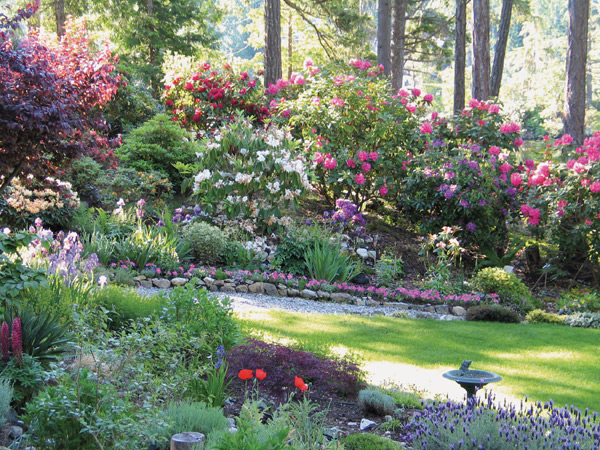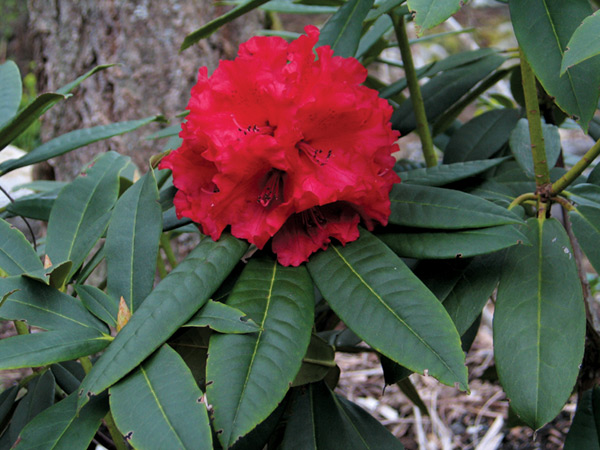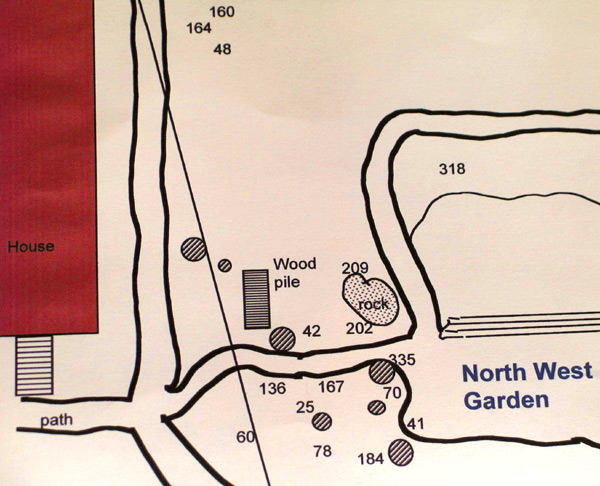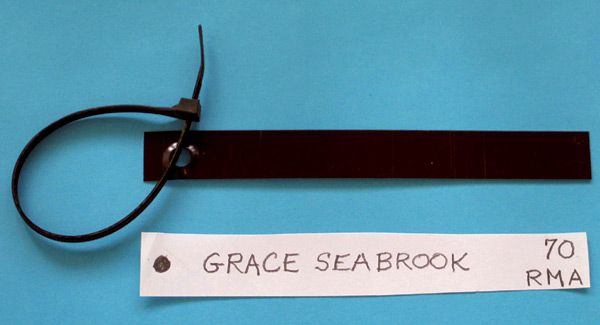JARS v60n2 - Garden Record Keeping: Using Computer Software for Garden Records, Part II
Garden Record Keeping: Using
Computer Software for Garden Records, Part II
Ron Knight
Vancouver, British Columbia
Canada
Once a rhododendron collection reaches several dozen plants, it's difficult to remember where each one is located or who sold you that yellow blooming 'Purple Splendour'. With a few hundred rhododendrons, the task becomes virtually impossible. Moreover, making and modifying hand-drawn garden maps and lists of information about each plant can be a cumbersome task.

|
|
In this small section of the author's
garden, there are over 100 rhododendrons.
It is difficult to remember details and locations for all of them. Photo by Ron Knight |
A simple solution to garden record-keeping problems is to put plant information into a computer database. For PC users, a well-known database program is called "Access" and it is included in the Microsoft Office Professional edition. The equivalent program for Macintosh users is the AppleWorks database which comes bundled with iMac computers.
A rhododendron database is like a deck of index cards. Each card, called a "record," contains information about one rhododendron. On the cards are preprinted boxes, called "fields," into which separate bits of information about each plant can be entered. The fields can each have a unique title and can be set up in any shape, size, color, or order that the gardener chooses.
The specific information in each field can be input in either text or numerical format. For example:
• a code for the plant's location in the garden
• a text entry giving its name
• a number showing its height in ten years
• a description of its flower color
• a rating of its foliage
• a date telling when it was planted
• a box to allow entry of miscellaneous information, such as where the plant was purchased
• an identification number corresponding to a number on the tag attached to each rhododendron in the garden
Figure 1 shows the fields that are entered in the author's database for the rhododendron 'Grace Seabrook'. Most of this information was obtained from books by Greer and Cox. Eight such records can be printed on a standard sheet of paper although more entries per page are possible with a reduced type pitch.

|
| Figure 1. |
The real pay-off with databases is that the imaginary deck of index cards can be instantly resorted according to a gardener's wishes. An alphabetical sort is a logical choice; it's useful to take a printed copy to a nursery when purchasing rhododendrons, to help remember which varieties are already in the collection. On occasion, a sort by planting dates might be of interest. As new plants are added to the garden, or as specimens are lost, the computer can be asked to re-sort all data.
Another database advantage is that a subset of all the rhododendron records can be requested, based on certain fields. For example, the computer could be asked to show just the imaginary index cards that have information about white dwarf specimens, all species rhododendrons in the collection, or all plants in one specific room of the garden.

|
|
Locating R. 'Grace Seabrook' in a
large garden is easy
with the help of a computer database and map. Photo by Ron Knight |
Pinpointing the exact location of each rhododendron in a large garden can be simplified by using the database in conjunction with a map drawn by the computer or by hand. In the author's one-acre garden, each room is given a one or two letter location code. For example, in Figure 1, the database record for 'Grace Seabrook' indicates that she is located at "NW” which stands for the north-west garden. Part of the computer map for this room in the author's garden is shown in Figure 2.

|
| Figure 2. |
This sketch map of the north-west garden was created with the aid of a computer drawing program. Then, a unique identification number for 'Grace Seabrook' (#70) was typed onto the map in the exact planting location. In the north-west garden, 'Grace Seabrook' has an aluminum tag attached to one of her branches, showing her identification number, as well as a code for red colour (R), medium height in ten years (M), and April bloom time (A) (see Figure 3). The number simply indicates that 'Grace Seabrook ' was the 70th plant to be purchased for the collection.

|
| Figure 3. |
In order to locate 'Grace Seabrook', a look at the author's alphabetical database of 450 rhododendrons shows that this plant is number 70, and is located somewhere in the north-west garden. Then, a glance at the map of this area pinpoints her exact location below the rock, between 'Apricot Fantasy' (#41) and 'Walt's Legacy' (#335).
Databases are relatively easy to create and can be designed by individual gardeners to fit any conceivable garden situation. The initial layout requires a few hours of work and about the same level of computer sophistication as is needed to set up and use a spreadsheet. However, after this initial layout is completed, new rhododendron records can be input in less than a minute each. Best of all, databases are fun to use, and they eliminate the drudgery of manual garden record-keeping.
Ron Knight is a past-president of the Vancouver Chapter. His rhododendron garden is located on British Columbia's Sunshine Coast.
